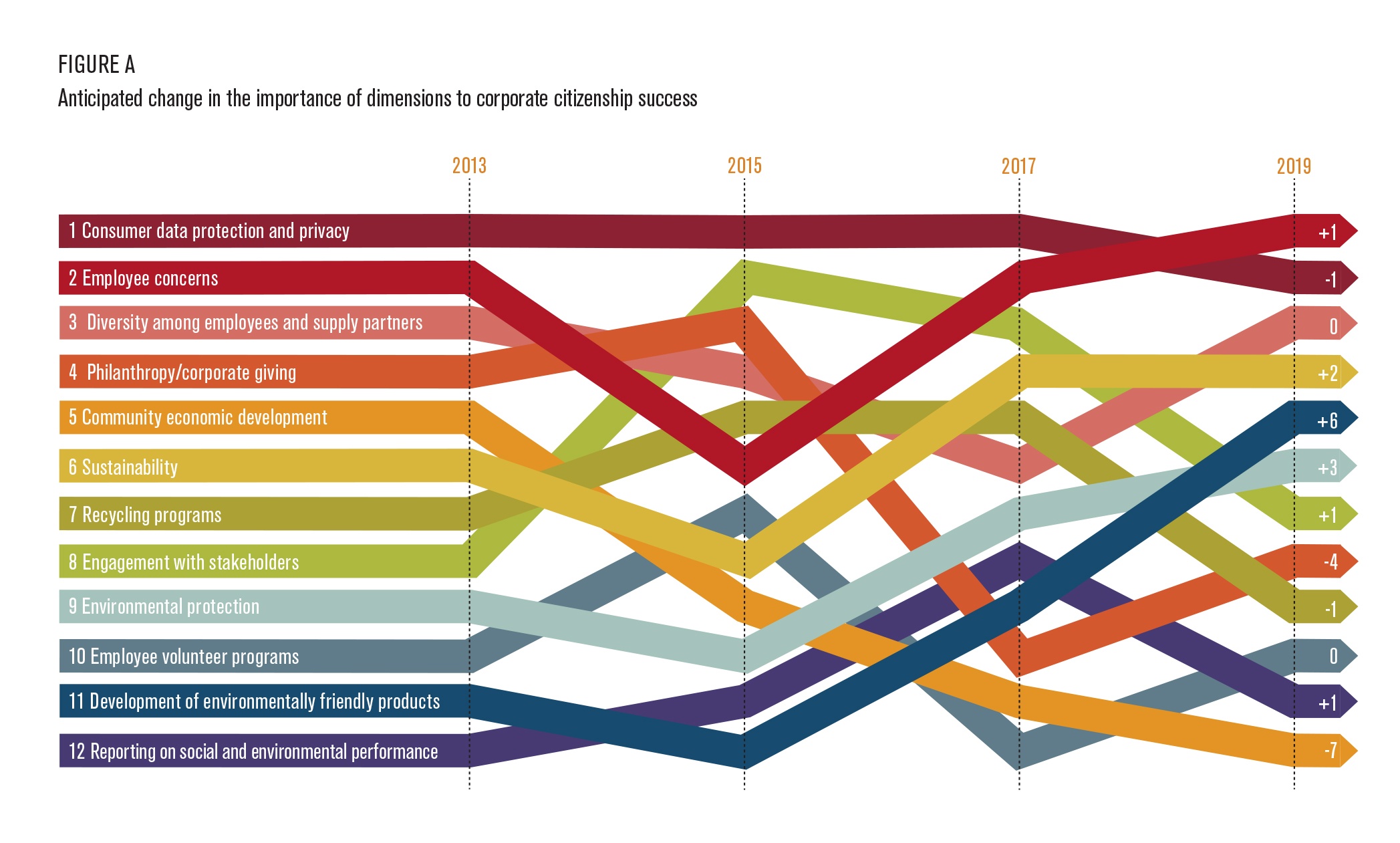Today’s companies face substantial pressure from stakeholders—both internal and external—to monitor and report on a variety of environmental metrics. The benefits to the company are clear, as research shows that successfully managing a company’s environmental footprint can strengthen a firm’s financial performance[i], help them maintain that performance over the long term[ii], improve the company’s image,[iii] and identify and mitigate potential risks to operations.[iv]
The executives surveyed in the Center’s 2017 State of Corporate Citizenship recognize the business and social value that can be achieved through environmental investments and are increasingly focused on these issues. The majority of executive respondents reported that they expect sustainability, environmental protection, and the development of environmentally friendly products advance in importance by 2019. (see Figure A). The majority also reported that they planned to increase resources for every listed environmental dimension—including sustainable resource use and pollution prevention practices—over the next three years.
Reporting progress against environmental sustainability goals can be tricky, but there are ways to better ensure the success of your efforts. Here are a few ideas to get you started:
- Set data-driven goals. Goal-setting is a vital part of carbon reduction efforts, and firms that set aggressive and/or long-term targets are more successful in meeting them.[v]
- Incentivize the changes. Monetary incentives for managers related to environmental efforts are found to be effective tools in reducing emissions.[vi]
- Choose programs that are easy to implement rather than disruptive to the operation of the firm. While bigger initiatives will likely lead to more drastic benefits and reductions, firms just starting out should begin small and build on their success over time.[vii]
- Measure to a standard. To measure both impacts and efforts most efficiently, many companies turn to reporting standards like GRI, <IR>, or CDP, which offer a consistent framework for companies to report on social, environmental, economic, and governance dimensions of their business. By making use of a standard, companies can better understand how their programs contribute to the bigger picture, determine where more work needs to be done, and align their efforts with those of other organizations.
- Communicate progress. It’s important to communicate how you’re investing in environmental efforts and why to relevant stakeholders. Doing so takes some work on the front end, but pays off in the long run—literally. Research finds that firms that invest heavily in internal programs, but do not communicate them to external stakeholders, do not make the same gains in market performance as those that do communicate their efforts.[viii]
Whether companies are responding to stakeholder pressure, trying to reduce cost, reducing risk in their supply chain, or improving their image, environmental sustainability offers great opportunities. Members can check out a webinar on demand to learn from companies that manage their environmental risk, measure their results, and have built the business case for doing so. Not a member? Learn more about how the Boston College Center for Corporate Citizenship can help you get the most from your programs by calling 617 552 4545 or emailing ccc@bc.edu.
[i] Delmas, M. A., Etzion, D., & Nairn-Birch, N. (2013).Triangulating environmental performance: What do corporate social responsibility ratings really capture? The Academy of Management Perspectives, 27(3), 255-267.
[ii] Ortiz‐de‐Mandojana, N., & Bansal, P. (2015). The long‐term benefits of organizational resilience through sustainable business practices. Strategic Management Journal.
[iii] Olsen, M. C., Slotegraaf, R. J., & Chandukala, S. R. (2014). Green claims and message frames: how green new products change brand attitude. Journal of Marketing, 78 (5), 119-137.
[iv] Matsumura, E.M., Prakash, R., & Vera-Munoz, S.C. (2013). Firm-Value Effects of Carbon Emissions and Carbon Disclosures. The Accounting Review, 89 (2), 695-724.
[v] Ioannou, I., Li, S. X. & Serafeim G. (2016). The effect of target difficulty and incentives on target completion: The case of reducing carbon emissions. The Accounting Review (In Press).
[vi] Ioannou, et al. (2016).
[vii] Dowell, G. W., & Muthulingam, S. (2016). Will firms go green if it pays? The impact of disruption, cost, and external factors on the adoption of environmental initiatives. Strategic Management Journal.
[viii] Hawn, O., & Ioannou, I. (2016). Mind the gap: The interplay between external and internal actions in the case of corporate social responsibility. Strategic Management Journal.









